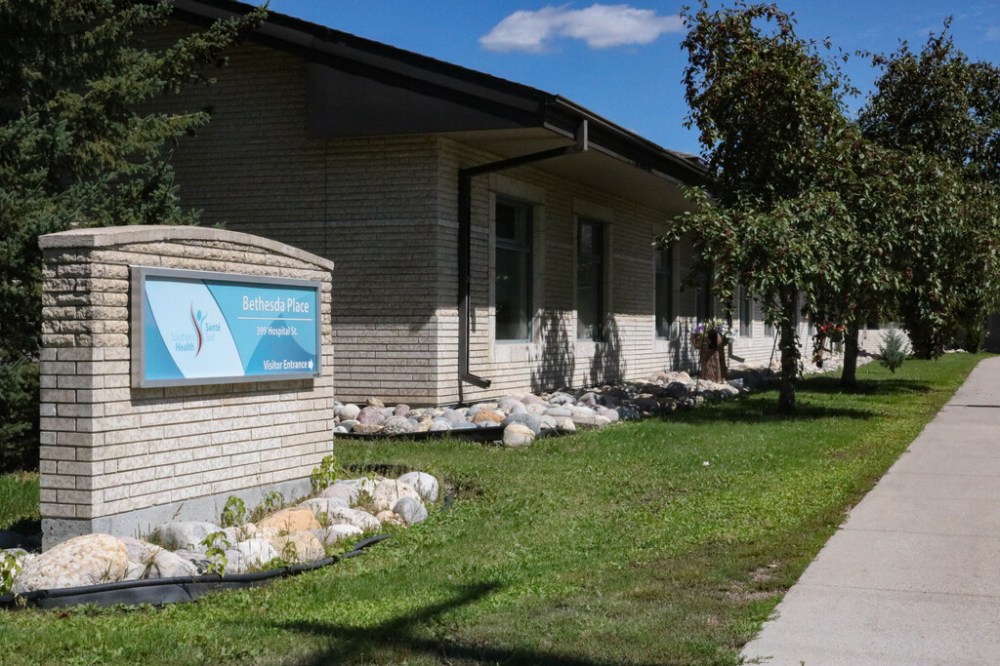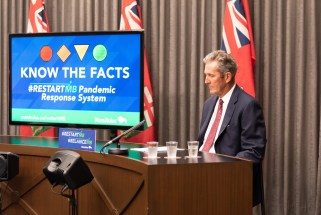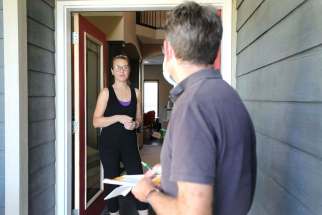Colour-coded COVID scale implemented to give Manitobans up-to-date snapshot, allow targeted actions
Read this article for free:
or
Already have an account? Log in here »
To continue reading, please subscribe:
Monthly Digital Subscription
$0 for the first 4 weeks*
- Enjoy unlimited reading on winnipegfreepress.com
- Read the E-Edition, our digital replica newspaper
- Access News Break, our award-winning app
- Play interactive puzzles
*No charge for 4 weeks then price increases to the regular rate of $19.00 plus GST every four weeks. Offer available to new and qualified returning subscribers only. Cancel any time.
Monthly Digital Subscription
$4.75/week*
- Enjoy unlimited reading on winnipegfreepress.com
- Read the E-Edition, our digital replica newspaper
- Access News Break, our award-winning app
- Play interactive puzzles
*Billed as $19 plus GST every four weeks. Cancel any time.
To continue reading, please subscribe:
Add Free Press access to your Brandon Sun subscription for only an additional
$1 for the first 4 weeks*
*Your next subscription payment will increase by $1.00 and you will be charged $16.99 plus GST for four weeks. After four weeks, your payment will increase to $23.99 plus GST every four weeks.
Read unlimited articles for free today:
or
Already have an account? Log in here »
Hey there, time traveller!
This article was published 19/08/2020 (1938 days ago), so information in it may no longer be current.
Manitobans can now go online to find out how much of a risk COVID-19 presents, what to do about it and the places they need to avoid or increase their vigilance.
The province unveiled its #RestartMB Pandemic Response System Wednesday that features a scale with four colour-coded levels: low-risk green — when the virus is broadly contained and a vaccine or treatment is available; cautionary yellow; restricted orange, indicating the virus is spreading through the community; and red — when the situation is critical and the virus is spreading out of control or there’s a significant strain on the health-care system.

On Wednesday, Bethesda Place nursing home in Steinbach was listed as “critical” with a red stop sign icon. Although there is just one COVID-19 case reported there, the risk to residents warrants restrictions. The entire province rated a yellow “caution” triangle Wednesday, signalling Manitobans should follow the current recommendations.
The beauty of the colour-coded response system is it allows public health to target sectors, regions or facilities at an elevated risk level without having to impose broad shutdown orders, chief provincial health officer Dr. Brent Roussin told a news conference accompanied by Premier Brian Pallister.
“This will provide Manitobans with clear, detailed and localized information about the risk responses and recommended action we can all take to prevent the spread of COVID-19,” Pallister said.

“It’s an overall picture of the situation throughout the province with specific, targeted measures that may be put in place by region, by community, by sector and/or site.”
The information can be updated quickly so it’s current, and is based on COVID-19 indicators monitored by public health.
The simple, colour-coded visual aid is based on a complex set of indicators and variables. It’s easy on the eyes but difficult to explain when restrictions will be dialed up or down.
Unlike the roadside forest fire hazard dial Manitobans are familiar with, the risk level isn’t determined by simple measurements such as temperature, precipitation or wind direction.
The pandemic response system is based on indicators that include community transmission rates, test-positive percentages, the capacity of hospitals and the public health system, the risk of importation of the virus and when there are outbreaks in vulnerable settings, such as the Steinbach nursing home.

It goes well beyond looking at one indicator in isolation, Roussin explained.
“We could see a test positivity rate of three per cent but we know that the majority of those positives are part of a known cluster that’s isolated, that’s contained,” he said. “Then we would not necessarily rely on the test positivity rate. We could be in a situation where we saw 1.5 per cent test positivity but saw widespread outbreaks and a strain on our health-care system. Then, we might have to have restrictions.”
For example, Manitoba’s community transmission rate is close to 18 per cent — above the 12 per cent level the province was at earlier and Roussin was OK with — but it’s not high enough to implement further restrictions, considering other factors, such as health-care system capacity. Just six people are hospitalized with COVID-19 in the province, Roussin noted.
“This will provide Manitobans with clear, detailed and localized information about the risk responses and recommended action we can all take to prevent the spread of COVID-19.”
– Premier Brian Pallister
Restrictions can also be applied or rolled back on schools, individual businesses or sectors, child-care centres, gyms, casinos and elsewhere, if COVID-19 risk is elevated.
Most of the cases in Winnipeg and Brandon are linked to clusters or other known cases, but there is evidence of community spread in both cities — particularly Brandon — that public health officials are watching closely, he said.
“That could be an area where we see it going to that next level of restriction,” he said.
Roussin ruled out more specific geographical information for the system in a place such as Winnipeg, saying that would not be helpful. Someone who tests positive could live in north Winnipeg, work in west Winnipeg and have family in south Winnipeg, he said.
Situations such as the one in Niverville/Ritchot health district that has a COVID-19 cluster and the most active cases in the Southern health region — but none are in the town of Niverville or the RM of Ritchot — are tricky, said Roussin, who stopped identifying cases reported on Hutterite colonies to avoid stigmatization.
“Health districts sometimes don’t have great names,” he said. “We’re back at that balance of identifying certain groups and the risk and benefits of doing that.”
carol.sanders@freepress.mb.ca

Our newsroom depends on a growing audience of readers to power our journalism. If you are not a paid reader, please consider becoming a subscriber.
Our newsroom depends on its audience of readers to power our journalism. Thank you for your support.







